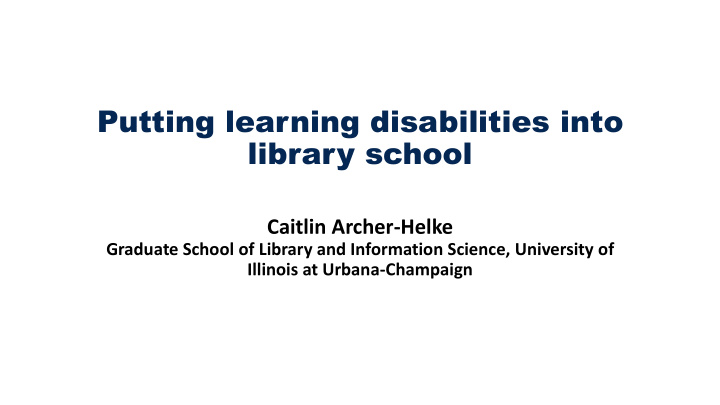



Putting learning disabilities into library school Caitlin Archer-Helke Graduate School of Library and Information Science, University of Illinois at Urbana-Champaign
What is dyslexia?
For more… • Alexander-Passe, N. (2006). How dyslexic teenagers cope: An investigation of self-esteem, coping, and depression. Dyslexia, 12 (4), 256-275. DOI: 10.1002/dys.18 • Björklund, M.M. (2011). Dyslexic students: Success factors for support in a learning environment. Journal of Academic Librarianship, 37 (5), 423-429. DOI: 10.1016/j.acalib.2011.06.006 • Chandrasaekaran, B., Hornickel, J., Skoe, E., Nicol, T., & Kraus, N. (2009). Content-dependent encoding in the human auditory brainstem relates to hearing speech in noise: Implications for developmental dyslexia. Neuron, 64 (3), 311-319. Retrieved from http://dx.doi.org/10.1016/j.neuron.2009.10.006 • Evans, W. (2013). “I am not a dyslexic person I’m a person with dyslexia”: Identity constructions of dyslexia among students in nurse education. Journal of Advanced Nursing, 70 (2), 360-372. DOI: 10.1111/jan.12199 • Richlan, F., Kronbichler, M., & Wimmer, H. (2013). Structural abnormalities in the dyslexic brain: A meta-analysis of voxel-based morphometry studies. Human Brain Mapping, 34, 3055-3065. DOI: 10.1002/hbm.22127
Why dyslexia? • Dyslexia • We're everywhere...but we're barely present in library and information science curricula. Let's change this, and work towards representation of people with learning disabilities in LIS education so we can better serve tomorrow's patrons at tomorrow's libraries. • Why Dyslexia? • It is relatively common, meaning that dyslexics are everywhere. A body of scientific research is focused on better understanding it, yet very little is written in library and information science journals about serving patrons with dyslexia.
Why Should I Care? • Not so long ago, people with learning disabilities, including dyslexia, were classified as stupid or difficult. By educating ourselves so we can better understand and support dyslexics, we can work to prevent a return to this sort of thinking, as well as ensure that dyslexic students feel less out of place in LIS classrooms—and that our patrons receive a higher standard of service. • Since dyslexia can affect dyslexics’ mental health, ensuring that they feel accepted and safe in their environments—whether they be school or professional—is even more important. • Luckily, many accommodations are easy to make.
Bringing Dyslexia into the Classroom
Commonalities What do these measures have in common? They will be helpful for lots of people, not just patrons and students with dyslexia.
Working Together Dyslexia is never going anywhere ever, but we can work together to ensure that our dyslexic peers feel less alone (and alien) in their LIS classes, and that tomorrow’s librarians are prepared to serve tomorrow’s dyslexic patrons.
Selected Sources • Chandrasaekaran, B., Hornickel, J., Skoe, E., Nicol, T., & Kraus, N. (2009). Content-dependent encoding in the human auditory brainstem relates to hearing speech in noise: Implications for developmental dyslexia. Neuron, 64 (3), 311-319. Retrieved from http://dx.doi.org/10.1016/j.neuron.2009.10.006 • Evans, W. (2013). “I am not a dyslexic person I’m a person with dyslexia”: Identity constructions of dyslexia among students in nurse education. Journal of Advanced Nursing, 70 (2), 360-372. DOI: 10.1111/jan.12199 • Ingesson, S.G. (2007). Growing up with dyslexia: Interviews with teenagers and young adults. School Psychology International, 28(5), 574-591. DOI: 10.1177/0143034307085659 • International Federation of Library Associations and Institutions. (2014). Dyslexia? Welcome to our library!: Inspiration for library services to persons with dyslexia. Retrieved from http://www.ifla.org/files/assets/lsn/publications/dyslexia-guidelines-checklist.pdf • International Federation of Library Associations and Institutions. (2014, 30 July). Draft IFLA guidelines for persons with dyslexia: Revised and enlarged. Retrieved from http://www.ifla.org/node/8934 • Olofsson, A., Ahl, A., & Taube, K. (2012). Learning and study strategies in university students with dyslexia: Implications for teaching. Procedia—Social and Behavioral Sciences, 47 , 1184-1193. Retrieved from http://dx.doi.org/10.1016/j.sbspro.2012.06.798 Rello, L., & Baeza-Yates, R. (2013). Good fonts for dyslexics. ASSETS ’13: Proceedings of the 15 th International ACM SIGACCESS • Conference on Computers and Access ability, article 14. DOI 10.1145/2513383.2513447 • Rello, L., Pielot, M., Marcos, M.C., & Carlini, R. (2013). Size matters (spacing not): 18 points for a dyslexic-friendly Wikipedia. WPA ’13: Proceedings of the 10 th Annual Cross-Disciplinary Conference on Web Accessibility, article 17. DOI 10.1145/2461121.2461125 • Richlan, F., Kronbichler, M., & Wimmer, H. (2013). Structural abnormalities in the dyslexic brain: A meta-analysis of voxel-based morphometry studies. Human Brain Mapping, 34, 3055-3065. DOI: 10.1002/hbm.22127 • Rutledge, H. (2002). Dyslexia: Challenges and opportunities for public libraries. Journal of Librarianship and Information Science 34 (3), 135-144. DOI: 10.1177/096100060203400302
Acknowledgments I would never have gotten here without parents who didn’t give up on me and a huge extended family at my back—so this is for them.
Caitlin Archer-Helke archerh2@Illinois.edu carcherhelke.com MA in Spanish, 2013 MSLIS with Certificate in Community Informatics, May 2015
Recommend
More recommend